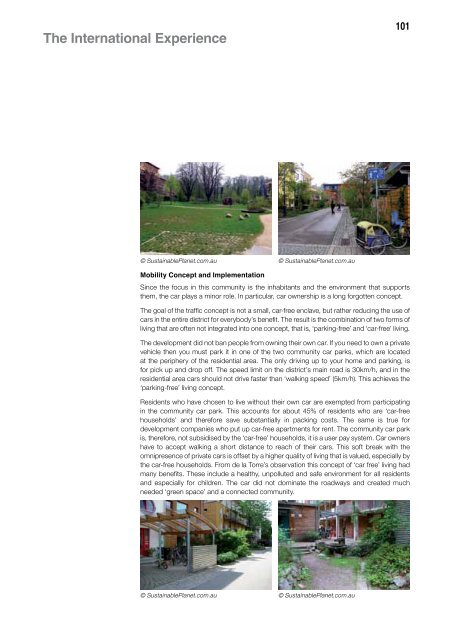Renewable and Sustainable Energy Technology - International ...
Renewable and Sustainable Energy Technology - International ...
Renewable and Sustainable Energy Technology - International ...
You also want an ePaper? Increase the reach of your titles
YUMPU automatically turns print PDFs into web optimized ePapers that Google loves.
The <strong>International</strong> Experience101© <strong>Sustainable</strong>Planet.com.au© <strong>Sustainable</strong>Planet.com.auMobility Concept <strong>and</strong> ImplementationSince the focus in this community is the inhabitants <strong>and</strong> the environment that supportsthem, the car plays a minor role. In particular, car ownership is a long forgotten concept.The goal of the traffic concept is not a small, car-free enclave, but rather reducing the use ofcars in the entire district for everybody’s benefit. The result is the combination of two forms ofliving that are often not integrated into one concept, that is, ‘parking-free’ <strong>and</strong> ‘car-free’ living.The development did not ban people from owning their own car. If you need to own a privatevehicle then you must park it in one of the two community car parks, which are locatedat the periphery of the residential area. The only driving up to your home <strong>and</strong> parking, isfor pick up <strong>and</strong> drop off. The speed limit on the district’s main road is 30km/h, <strong>and</strong> in theresidential area cars should not drive faster than ‘walking speed’ (5km/h). This achieves the‘parking-free’ living concept.Residents who have chosen to live without their own car are exempted from participatingin the community car park. This accounts for about 45% of residents who are ‘car-freehouseholds’ <strong>and</strong> therefore save substantially in packing costs. The same is true fordevelopment companies who put up car-free apartments for rent. The community car parkis, therefore, not subsidised by the ‘car-free’ households, it is a user pay system. Car ownershave to accept walking a short distance to reach of their cars. This soft break with theomnipresence of private cars is offset by a higher quality of living that is valued, especially bythe car-free households. From de la Torre’s observation this concept of ‘car free’ living hadmany benefits. These include a healthy, unpolluted <strong>and</strong> safe environment for all residents<strong>and</strong> especially for children. The car did not dominate the roadways <strong>and</strong> created muchneeded ‘green space’ <strong>and</strong> a connected community.© <strong>Sustainable</strong>Planet.com.au © <strong>Sustainable</strong>Planet.com.au

















